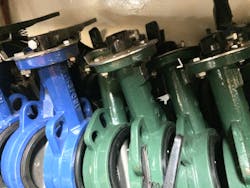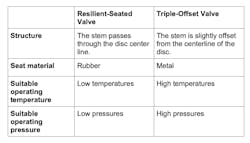Assess the Pros, Cons and Best Practices of Butterfly Valves
Improper use of industrial valves can be catastrophic. Indeed, the chemical industry should have learned some important lessons from the Phillips 66 Houston Chemical Complex explosion and fire in 1989. This accident, which resulted from extremely flammable process gases escaping during regular maintenance operations on one of the plant's polyethylene reactors, helped revolutionize the design, safety standards and maintenance requirements for different industrial valves. The standards include teaming process engineers with manufacturers to optimize valve designs. The aim is to ensure they meet the desired valve performances and contain adequate fail-safe mechanisms to avert accidents.
In the Phillips 66 incident, isolation valves were closed and compressed air hoses that actuated them physically disconnected as a safety measure according to the Occupational Safety and Health Administration investigation. The air connections for opening and closing this valve were identical and had been improperly reversed when reconnected.
Industrial butterfly valves have fail-safe designs and lockout systems that minimize human errors and media-initiated stresses that can cause workplace and environmental accidents.
How Butterfly Valves Work
Industrial butterfly valves are expected to control fluid flow in different pipe configurations while preventing media leakage to downstream processes and the atmosphere around their bodies and connection points.
There are several components in a butterfly valve that enable its effective operation. The metal disc, commonly referred to as the butterfly is the most important component. The disc is always present in the path of flow. This means that the flow control mechanism continuously induces a slight pressure drop in the piping system. Butterfly valves use compact internal designs to limit the pressure drop and improve their responsiveness for optimal pressure recovery and optimized flow coefficients when conveying different fluid media.
Butterfly valves are vital for several industrial applications, including petrochemical processing. These valves can start or stop the flow, regulate and isolate fluids in pipelines and prevent backflow.
Fluid flow past the butterfly valve is controlled by manipulating the position of the disc. The position of the disc provides a full or partial bore for desired fluid control. Some butterfly valves can provide restricted passage by opening at an angle below 90 degrees. In restricted passage mode, only smaller amounts of the fluid will pass through. Maximum flow is achieved when the lever turns a full 90 degrees.
Butterfly valves can be used for modulating flow. For this purpose, they could be designed to obtain linear or equal percentage characteristics.
Key Valve Characteristics
Near linear
Linear percentage characteristic means that if the valve is opened to about N% of the full turn, the flow rate through will also be N% of the maximum flow rate. So, if the degree of opening is at 40% of 90 degrees, the flow rate will be 40% of the maximum flow rate.
Quick opening
This means there is a rapid increase in the flow rate as the opening angle is increased incrementally from the closed position.
Types of Butterfly Valves
There are different design standards for butterfly valves, such as API 609, ISO 5752, and can be categorized under the following:
1. Disc closure
Disc closure is a function of the valve stem. The valve stem location, relative to the disc and the surface angle of the seat, forms the bedrock of different disc closure designs.
Concentric
In this type of butterfly valve, the stem is located at the centerline of the disc, which is also at the center of the bore. It has zero offsets and can also be referred to as a resilient-seated valve.
Resilient-seated butterfly valves are suitable for flow systems with low pressure and low temperatures, such as water lines.
Eccentric
In eccentric butterfly valves, the stem is not located at the centerline of the disc. Eccentric valves can be single offset, double offset or triple offset. The triple offset valve is like the double offset but with a third offset. The stem passes behind the disc and is slightly offset from the disc centerline.
Differences Between the Resilient-Seated Butterfly Valve and the Triple-Offset Valve
2. Connection
Butterfly valve connection refers to the type of design used to connect the valve to the piping system. Most industrial butterfly valves are flanged and are assigned temperature and pressure ratings following the ASME B16.5 standard. The pressure ratings for the flanged butterfly valves can be 150#, 300# and 600#, with extreme pressure valves ranging from above class 600# to 2500#.
Lug style
The lug design uses lugs located outside the body. With this design, one can disconnect branch connections without affecting the other. It is useful when carrying out dead-end service — that is, disconnecting the flange downstream and still maintaining the pressure and pipe connections upstream.
Wafer style
The bolts used are long enough to cover both flange ends and the body. This type of butterfly valve is suitable when sealing is required in the pipe system to prevent bidirectional pressure differences in the flow.
3. Actuation
There are several ways to operate butterfly valves. Valve operation can be achieved manually, using handles or incorporating gears. Automatic operation requires the use of electric, pneumatic or hydraulic actuators.
Automatic actuation is suitable when there is a need to operate the valve remotely. Carefully consider the selection criteria for the butterfly valve before selecting an actuator. The table below states the best-suited piping system for different actuators.
Choosing the correct valve actuator is vital for maximizing operational safety and eliminating system breakdowns. The actuator should deliver adequate torque to open and close the valve when required.
The force requirements for different butterfly valves vary depending on their sizes, and the nature of fluids conveyed by the piping system. Disc design also determines the torque requirements of the actuator. It’s important to keep force requirements at a minimum. This affects the size of actuators, complementary actuation devices like pneumatic reservoirs, pressure relief valves and connection hoses.
To lower torque requirements on actuators, process engineers should consider using butterfly valves with undercut discs for low-pressure fluid applications. These valves have smaller disc diameters to minimize the torque needed to seat and unseat valves. Aside from reducing torque requirements, undercut valve seats have a more durable life in low-pressure applications.
The actuator is connected to the valve stem using specially designed mountings or adapters. It implies the actuator may be exposed to the service media if not carefully installed or if the coupling and actuator housing material is incompatible with the service media. Engineers should explicitly understand the chemical and physical properties of the service media to ensure the actuator body and connection parts are made from compatible, durable and strong materials.
The other considerations when choosing actuators for industrial butterfly valves are the desired cycling requirements and actuation speeds. Some industrial valves are frequently cycled and require actuators with high-duty cycles. The frequent cycling can cause a build-up of heat around the valve and may damage the valve trim and actuator coupling components.
Additionally, frequently cycled, high-pressure fluid applications rely on fast-acting actuators. Such systems will use pneumatic, hydraulic or high-speed solenoid actuators.
Process engineers should also consider the safety designs associated with different actuators. The fail-safe design provides a redundancy system to protect the piping system, along with other equipment in the facility, during emergencies — to allow sequential shutdown, repairs and system restoration.
Pros and Cons Of Butterfly Valves
Butterfly valves may be applied in several ways, but they are nevertheless limited. A typical example is modulating operations which require several considerations, such as pneumatic positioners and others, for the proper functionality of quarter-turn valves in chemical applications.
Pros of butterfly valves
Butterfly valves are popular across different industries because of their unique performance characteristics derived from optimal trim designs, fabrication materials and responsiveness. Some notable advantages associated with butterfly valves include:
Sealing efficiency — butterfly valves provide leak-tight seals, making them preferable for sanitary applications and fluid applications where leakage jeopardizes the quality of processes as well as the safety of the employees and the environment. These valves use different seal materials depending on the type of service fluid and the leakage classes assigned to the valve. The quick action of butterfly valves implies the disc can move from an open or closed position faster in response to pressure variations in the pipeline or control signals sent via the actuator.
Compact design — butterfly valves are generally lightweight and feature compact internal designs. It means the valves occupy a small space compared to other valves and can be installed in confined spaces and perform their duties as intended. The compact design also lowers manufacturing costs since less material is used to fabricate the trim and the shell.
High-pressure recovery factors — butterfly valves respond faster to system changes. They also have low-pressure drops across the system despite the disc's presence in the path of fluid flow. The quick responsiveness of the valve ensures the pressure drop is limited, and the demand on pumps is reduced. With the high-pressure recovery factors, the valves can provide dependable fluid service devoid of backflows and leakages. It also helps companies to control pumping-related energy costs.
Cons of Butterfly Valves
Butterfly valves may fail to achieve the desired performance characteristics in some fluid applications. Some disadvantages of butterfly valves are:
Susceptible to cavitation — the availability of the fluid control mechanism in the path of fluid flow can be disadvantageous in situations where fluids contain substantial amounts of impurities. Debris can accumulate around the disc, increasing the valve’s susceptibility to choked flow and cavitation.
Butterfly valves are not piggable — cleaning valves is a part of routine pipeline maintenance. Some maintenance teams use pipeline intervention gadgets (pigs) to remove debris from pipelines and valves. However, pigging is untenable for piping systems using butterfly valves due to the positioning of the disc.
Choosing, Installing and Maintaining
When selecting valves for industrial applications, process engineers should evaluate their usability, maintainability and reliability throughout their useful life. There is no one-size-fits-all when selecting butterfly valves. As mentioned earlier, the choice of a butterfly valve for an application depends on the nature of the service fluid. Some fluids are corrosive, while others have varying chemical and physical properties, such as system temperature and pressure change. The properties of the service media will impact the choice of fabrication materials since they must offer sufficient corrosion resistance and strength to accommodate varying pipeline conditions. The valve should be fabricated, tested and installed following the acceptable industry and regulatory standards, and using the approved equipment calibration techniques.
During installation, process engineers must ensure the selected valve meets the desired performance criteria — flow rates, temperature and pressure ratings and shutoff characteristics. These valves should be installed four-to-six pipe diameters away from pipe components like elbows, pipe branches and nozzles. It reduces the negative impacts of turbulent flow on the valve trim. The valve should be tightened to appropriate torque standards to guarantee safety. Use the right tools to lift, align and test butterfly valves before and during installations.
Companies must establish reliable maintenance programs to extend the lives of industrial butterfly valves and enhance their long-term efficiency. Digital solutions, including condition-monitoring sensors for real-time valve performance tracking, can help eliminate underlying defects. Process engineers and maintenance teams should partner to optimize valve inspection schedules and ensure all preventative measures are implemented timely and correctly.
Butterfly valves are durable fluid-control devices with multiple uses in different industries. They are designed to have reduced internal wear, especially in triple offset butterfly valve design.
Choosing the right butterfly valve for an industrial fluid application reduces operational costs and enhances operational, occupational and environmental safety.
About the Author
Gilbert Welsford Jr.
Founder, ValveMan.com
Gilbert Welsford Jr. is the founder of ValveMan.com. He is a third-generation valve entrepreneur. Gilbert’s focus is building on the legacy his grandfather started, his father grew, and he has amplified.



